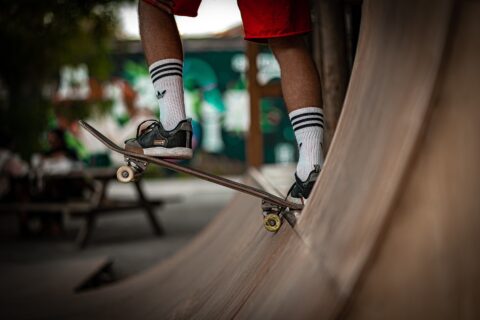ID 2316: Development of a Biomechanical Simulation of Skateboarding
Master’s Thesis
Skateboarding involves the interaction between the skateboard, the rider, and the environment. There are several factors that influence the dynamics of skateboarding, such as the rider’s center of mass, weight distribution, and angular velocity. In addition, the interaction between the skateboard and the ground affects the stability and performance of the rider during different motions. Recent literature investigated the optimal control of maneuvers like Ollies or a machine learning-based classification of different tricks. However, there is a lack of biomechanical modeling of the actual skateboard riding.
Biomechanical simulations exist for various movements. Walking and running in particular have been widely explored, while highly dynamic movements present numerous difficulties in motion data acquisition. For optical acquisition approaches, covering body parts in complicated movements is a major challenge, while acceleration data of these movements is potentially difficult to interpret. Skateboarding combines the challenges of dynamic movements with rapid changes in orientation of body parts and very small changes in the angle of the skateboard’s tilt, which are necessary for a stable ride. To investigate the kinematics and kinetics of that system, we can create biomechanical simulations using trajectory optimization. These simulations should consider the dynamics of the rider, skateboard, and environment, as well as recorded data to determine the optimal trajectory. Our physics-based model provides the basis for implementing such dynamics and thus making assumptions about various biomechanical parameters.
Therefore, this thesis proposes a biomechanical simulation of skateboarding using trajectory optimization, which will provide a comprehensive understanding of the dynamics involved in skateboarding. The simulation will be based on musculoskeletal modeling and formulating an optimal control problem, considering the dynamics of the rider, skateboard, and environment. Measurements of straight and alternating curved travel on an instrumented treadmill are available to serve as tracking data. Optical motion capture, as ground truth, and inertial motion capture were used. Additionally, inertial measurement data from the skateboard was also collected for some subjects. Our goal is to develop an approach to perform measurements of biomechanical parameters during skateboarding outside of the laboratory environment. Thus, a main topic of the thesis is to evaluate the quality of the inertial motion capture system and the possibility to use this technique for measurements ’in-the-wild’. The expected outcome of this thesis is a valuable tool for analyzing the biomechanics of skateboarders and for optimizing their performance.
Tasks
- Literature study into the dynamics of skateboard riding
- Implementation of these dynamics into a biomechanical simulation framework
- Comparison of simulated and measured data
- Analysis of performance parameters and the accuracy of the implemented simulation
Requirements
- Interest in biomechanics
- Experience in dynamics simulations and/or optimization
Supervisors
Please use the application form to apply for the topic. We will then get in contact with you.



